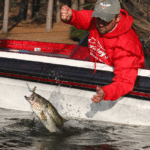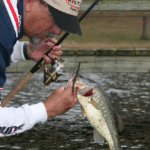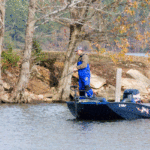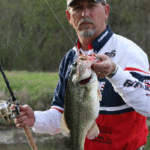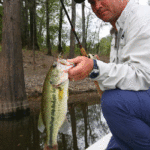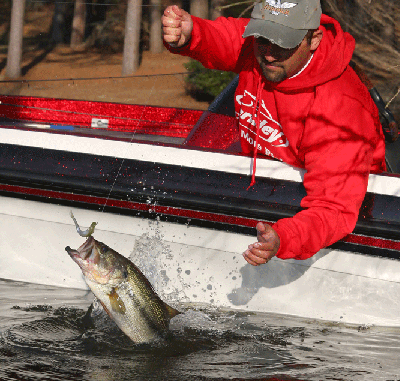
March is known for its unpredictable weather, but only subtle bass-fishing changes are needed when a late-season front blows through.
Bass angler, beware the Ides of March.
Not that you have to look over your shoulder for a group of friends intent on stabbing you 23 times in the back, but for approaching cold fronts that can do enough damage to take you out.
For North Louisiana bass anglers in particular, March can be the best of times, or it can be the worst of times. Just as soon as you think you’ve got the bite pinned down, a cold front blows through and messes everything up.
Rather than use cold fronts as an excuse for why they didn’t catch any fish, veteran bass anglers know the fronts are just another variable with which they have to contend during the spring.
Make the wrong adjustments, and you’ll swear there isn’t a bass in the lake. Make the right adjustments, and you’ll wonder what everybody else is griping about.
West Monroe’s Kenny Covington has been fishing local bass tournaments for so long that he is now seen as one of the old guys when his competitors start chatting him up at the weigh-in. And with so many March tournaments under his belt, he’s seen enough cold fronts to know that they aren’t the end of the world.
When asked how he adjusts to cold fronts that blow through North Louisiana during March, Covington’s pithy reply was, “It depends.”
Asked if he could be a little less vague, Covington replied that bass in the different lakes across North Louisiana respond differently to cold fronts based on the characteristics of the lake and the genetics of the bass.
“The two main factors I take into consideration when facing post-front fishing are whether a lake has a lot of Florida-strain bass and if it has grass,” he said. “Florida bass react to cold fronts completely different than native fish do. Take a lake like Caney, for instance. It was mass stocked with Florida bass. That’s why a cold front can shut that place down.”
On the other hand, lakes like D’Arbonne and Claiborne that have a mix of Florida and native bass aren’t affected as badly by cold fronts. The Florida fish may shut down, but the natives help to pick up the slack.
As for the grass, Covington feels like that is the one factor that can help bass weather the first couple days after a cold front. In fact, he has found that a windy post-front day can actually produce some pretty good fishing in the grass.
Aside from Florida bass and grass, Covington believes that the more specific effects of a cold front on bass have a lot to do with what stage of the spawn bass happen to be in at the time of the front.
“Up here in March, bass are either going to be prespawn or postspawn,” he noted. “When I’m on prespawn fish in 5 to 8 feet of water, I find those fish are a lot less affected by a front than those that are actually spawning in 1 to 3 feet.”
Covington went on to say that he believes one of the mistakes most often made by anglers after a cold front is that they retreat too far back into the main lake.
In his estimation, prespawn bass that have already committed to staging on a 5- to 8-foot flat more often just hunker down where they are, especially in the presence of grass or wood cover.
But if they do move back, Simsboro tournament angler and guide Sid Havard says they won’t move nearly as far as most folks think.
“The biggest tip I can give anybody who wants to be a good March cold-front fisherman would be to fish the very middle of the pocket after a front,” said Havard. “Bass that are up staging to spawn will sometimes pull back to the mouth of a pocket. But they won’t be on the bank; they’ll be right in the middle.”
So if prespawn bass either don’t move at all or move very little, what should an angler do to catch them? According to Covington, the best plan of action is to start with no adjustment at all.
The first thing he does is to go right back to where he caught them before the front and fish the same way he was catching them just a day before.
“You don’t know that they’ve even changed,” Covington said. “They may still hit what you’ve been throwing. I think a lot of people outthink themselves and believe that they have to fish a certain way after a front. It would be a shame to change the way you fish only to find out later that the fish didn’t change.”
After starting with whatever had been working, Covington begins to mix it up a little bit until he finds a pattern that the fish will eat. The first change he makes is to slow down and be patient.
He likened deeper prespawn bass to humans who have been enjoying five days of 80-degree weather. Then a front comes through with a 30-degree drop in temperature.
“What are you going to do?” Covington quipped. “You’re going to hunker down. You’re not going to go outside. You just want to hang out in the house and chill. You don’t want to do extreme things. Bass are the same way. In this case, you may have to make it very easy for them to eat by moving your baits really slow.”
If bass don’t respond to the slower presentation, Covington then switches to a smaller lure. It was a lesson he learned at Lake Claiborne a few years ago when he had been catching a lot of prespawn bass on Carolina-rigged lizards.
A cold front blew through the night before his tournament, and he couldn’t get bit even on a very slowly fished Carolina rig. Therefore, he went to the next step of going smaller.
“I went to a miniature Carolina rig with 10-pound-test line, a 1-foot leader and a pegged 3/8-ounce weight,” Covington recalled. “And I changed the 6-inch lizard to a 4-inch finesse worm. That was exactly what the bass wanted, and my partner and I went on to do very well in that tournament.”
Moving on in the process, Covington then tries the opposite end of the spectrum to see if he can trigger bass to bite out of a reaction rather than hunger. That’s when he picks a lipless crankbait like a Rat-L-Trap or a diving crankbait and tries to shake things up.
Havard has discovered recently that he can combine the best of both worlds by fishing a suspending jerkbait like a Lucky Craft Pointer 100. With this bait, he says he is able to combine an aggressive jerk with a long pause to make the fish bite.
“I do it a little different than most, though,” Havard said. “Rather than throw it on light line, I throw it on 20-pound-test because I’m looking for it to suspend 3 feet deep in about 5 feet of water.
“I like to reel it down two or three jerks and just stop it. What’s cool is that this bait will just sit there. It doesn’t move up, and it doesn’t move down. When you go to twitch it again, that’s when they can’t stand it and they eat it up.”
If bass are committed to the spawn and are locked on beds when a front blows through, Covington says this can present more of a challenge than if they were in a deeper prespawn phase.
In this case, bass, especially the females, will move away from the beds rather quickly. However, rather than vacate the area to go sulk back in their prespawn staging areas where many anglers believe they go, the larger females pull back to the first comfort zone like a stump or log.
“The way I look at it, the bigger the female, the quicker she’s leaving,” Covington said. “The males will stay behind, and you can still catch him after a front if you like to sight fish. But to catch the bigger females, you’re going to have to try something different.”
One of his main techniques in this case is to back off to the first line of heavy cover and blind cast a Texas-rigged Fluke or Senko with a small weight across the flat. Some other reliable lures that Covington uses in a post-front situation in shallow water are a Chatter Bait, Rat-L-Trap and 1/4-ounce spinnerbait.
“I’ve been doing really good here lately on that Chatter Bait after a front,” he said. “You can fish it so many different ways that you can adapt it to fit tough conditions. After a front, I like to bump it into shallow wood or rip it through grass. Either way, it makes that big female make a quick decision to eat.”
Cold fronts sneaking up over your shoulder aren’t out to get you this March, but they can make your best days turn into your worst if you let them throw you off your game.
Figuring out how to walk the fine line between not adjusting at all and adjusting too much is the key to ensuring the Ides of March don’t do you in.
